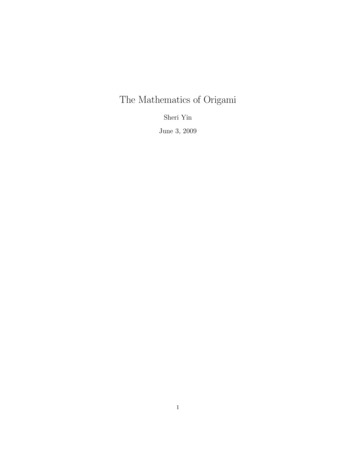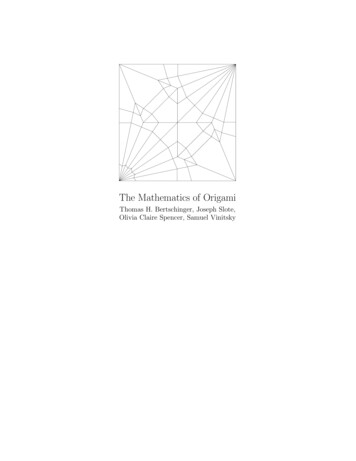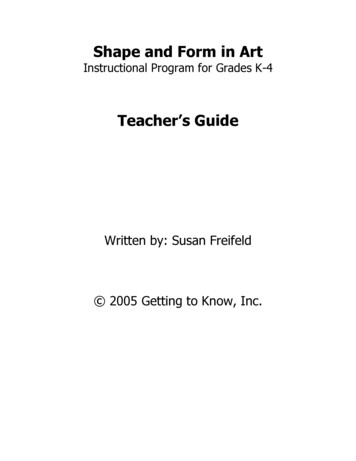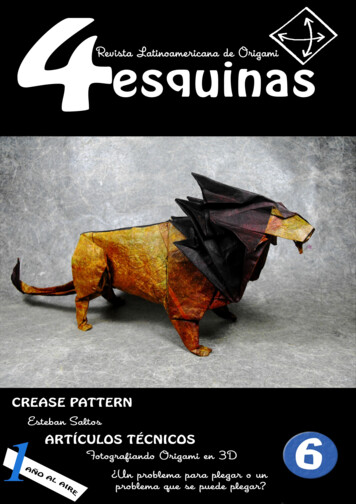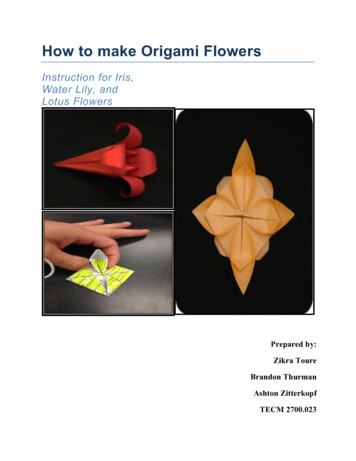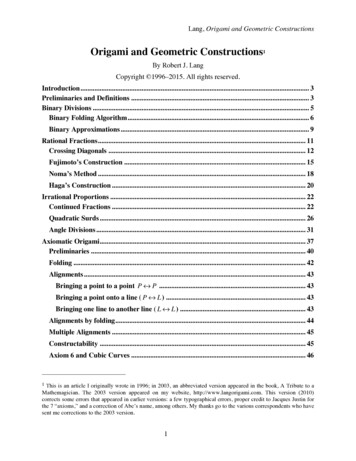
Transcription
Lang, Origami and Geometric ConstructionsOrigami and Geometric Constructions1By Robert J. LangCopyright 1996–2015. All rights reserved.Introduction . 3Preliminaries and Definitions . 3Binary Divisions . 5Binary Folding Algorithm . 6Binary Approximations . 9Rational Fractions. 11Crossing Diagonals . 12Fujimoto’s Construction . 15Noma’s Method . 18Haga’s Construction . 20Irrational Proportions . 22Continued Fractions . 22Quadratic Surds . 26Angle Divisions . 31Axiomatic Origami. 37Preliminaries . 40Folding . 42Alignments . 43Bringing a point to a point P P . 43Bringing a point onto a line ( P L ) . 43Bringing one line to another line ( L L ) . 43Alignments by folding . 44Multiple Alignments . 45Constructability . 45Axiom 6 and Cubic Curves . 461This is an article I originally wrote in 1996; in 2003, an abbreviated version appeared in the book, A Tribute to aMathemagician. The 2003 version appeared on my website, http://www.langorigami.com. This version (2010)corrects some errors that appeared in earlier versions: a few typographical errors, proper credit to Jacques Justin forthe 7 “axioms,” and a correction of Abe’s name, among others. My thanks go to the various correspondents who havesent me corrections to the 2003 version.1
Lang, Origami and Geometric ConstructionsApproximation by Computer . 50References . 542
Lang, Origami and Geometric ConstructionsIntroductionCompass-and-straightedge geometric constructions are familiar to most students from high-schoolgeometry. Nowadays, they are viewed by most as a quaint curiosity of no more than academicinterest. To the ancient Greeks and Egyptians, however, geometric constructions were useful tools,and for some, everyday tools, used for construction and surveying, among other activities.The classical rules of compass-and-straightedge allow a single compass to strike arcs and transferdistances, and a single unmarked straightedge to draw straight lines; the two may not be used incombination (for example, holding the compass against the straightedge to effectively mark thelatter). However, there are many variations on the general theme of geometric constructions thatinclude use of marked rules and tools other than compasses for the construction of geometricfigures.One of the more interesting variations is the use of a folded sheet of paper for geometricconstruction. Like compass-and-straightedge constructions, folded-paper constructions are bothacademically interesting and practically useful—particularly within origami, the art of foldinguncut sheets of paper into interesting and beautiful shapes. Modern origami design has shown thatit is possible to fold shapes of unbelievable complexity, realism, and beauty from a single uncutsquare. Origami figures posses an aesthetic beauty that appeals to both the mathematician and thelayman. Part of their appeal is the simplicity of the concept: from the simplest of beginningssprings an object of depth, subtlety, and complexity that often can be constructed by a preciselydefined sequence of folding steps. However, many origami designs—even quite simple ones—require that one create the initial folds at particular locations on the square: dividing it into thirdsor twelfths, for example. While one could always measure and mark these points, there is anaesthetic appeal to creating these key points, known as reference points, purely by folding.Thus, within origami, there is a practical interest in devising folding sequences for particularproportions that overlaps with the mathematical field of geometric constructions. Within thisarticle, I will present a variety of techniques for origami geometric constructions. The field is richand varied, with surprising connections to other branches of mathematics. I will show origamiconstructions based on binary divisions, and then show how these can be extended to constructionof proportions that are arbitrary rational fractions. Certain irrational proportions are alsoconstructible with origami; I will present several particularly interesting examples. I’ll then turnto the topic of approximate folding sequences, which, though perhaps not as mathematicallyinteresting, are of considerable practical utility. Along the way, I’ll present the axiomatic theoryof origami constructions, which not only stipulates what classes of proportions are foldable, butalso provides the basis for finding extremely efficient approximate folding sequences by computersolution—a technique that has found application in a number of published origami books ofdesigns.Preliminaries and DefinitionsOrigami, like geometric constructions, has many variations. In the most common version, onestarts with an unmarked square sheet of paper. Only folding is allowed: no cutting. The goal oforigami construction is to precisely locate one or more points on the paper, often around the edgesof the sheet, but also possibly in the interior. These points, known as reference points, are thenused to define the remaining folds that shape the final object. The process of folding the modelcreates new reference points along the way, which are generated as intersections of creases or3
Lang, Origami and Geometric Constructionspoints where a crease hits a folded edge. In an ideal origami folding sequence—a step-by-stepseries of origami instructions—each fold action is precisely defined by aligning combinations offeatures of the paper, where those features might be points, edges, crease lines, or intersections ofsame.Two examples of creating such alignments are shown in Figures 1 and 2. Figure 1 illustratesfolding a sheet of paper in half along its diagonal. The fold is defined by bringing one corner tothe opposite corner and flattening the paper. When the paper is flattened, a crease is formed that(if the paper was truly square) connects the other two corners.Figure 1. The sequence for folding a square in half diagonally.As a shorthand notation, the two steps of folding and unfolding are commonly indicated by asingle double-headed arrow as in the third step of Figure 1.Figure 2 illustrates another way of folding the paper in half (“bookwise”). This fold can be definedin 3 distinct, but equivalent ways:(1) Fold the bottom left corner up to the top left corner.(2) Fold the bottom right corner up to the top right corner.(3) Fold the bottom edge up to be aligned with the top edge.For a square, these three methods are equivalent. However, if you start with slightly skew paper (aparallelogram rather than a square), you will get slightly different results from the three.4
Lang, Origami and Geometric ConstructionsFigure 2. The sequence for folding a square in half bookwise.In both cases, if you unfold the paper back to the original square, you will find you have created anew crease on the paper. For the sequence of Figure 2, you will also have now defined two newpoints: the midpoints of the two sides. Each point is precisely defined by the intersection of thecrease with a raw edge of the paper.These two sequences also illustrate the rules we will adopt for origami geometric constructions.The goal of origami geometric constructions is to define one or more points or lines within a squarethat have a geometric specification (e.g., lines that bisect or trisect angles) or that have aquantitative definition (e.g., a point 1/3 of the way along an edge). We assume the following rules:(1) All lines are defined by either the edge of the square or a crease on the paper.(2) All points are defined by the intersection of two lines.(3) All folds must be uniquely defined by aligning combinations of points and lines.(4) A crease is formed by making a single fold, flattening the result, and (optionally) unfolding.Rule (4), in particular, is fairly restrictive; it says that folds must be made one at a time. By contrast,all but the simplest origami figures include steps in which multiple folds occur simultaneously.Later in this article, I will discuss what happens when we relax this constraint.Binary DivisionsOne of the most common origami constructions that turns up in practical folding is the problem ofdividing one or both sides of the square into N equal divisions, where N is some integer. Figure 2illustrated the simplest case—dividing the edge of a square into two parts—and its solution. Ofcourse, this method is not restricted to a square; it works equally well on any line segment in asquare. Thus, the two halves of the square may be individually divided into two parts, and so on.By repeatedly dividing the segments in half, it is possible to divide the edge of a square (orrectangle) into 4ths, 8ths, and so forth, as shown in Figure 3.5
Lang, Origami and Geometric ConstructionsFigure 3. Division of a square into 4ths, 8ths, and 16ths.This method allows us to divide a square into proportions of 1/2, 1/4, 1/8, and in general, 1/2 nfor integer n. Each division is 1/2 n of the side of the square. By scaling all numbers to the size ofthe square, we can say we have constructed the fraction 1/2 n , where the fraction is given in termsof the side of the square.It is also possible to construct a fraction of the form m /2 n for any positive integer m 2 n . (In allthe discussion that follows, we will consider only fractions between 0 and 1.) The most directmethod is to subdivide the edge of the square completely into 2 n ths, then count up m divisionsfrom the bottom. This method clearly requires 2 n 1 creases, and is not very efficient, becausecompletely subdividing the square results in the creation of many unnecessary creases. There is anelegant method for constructing any fraction of this type that uses the minimal number of folds. Arational fraction whose denominator is a perfect power of two is called a binary fraction; thefolding method is called the binary folding algorithm.Binary Folding AlgorithmThe binary folding algorithm was described by Brunton [1] and expanded upon by Lang [2]. Itproduces an efficient folding sequence to construct any proportion that is a binary fraction and isbased on binary notation. In binary notation, there are only two digits, 1 and 0; all numbers arewritten as strings of ones and zeros. Any number can be written in binary notation as a string ofones and zeros. For example, the numbers 1 through 10 can be written in binary as shown in Table1.6
Lang, Origami and Geometric 8100091001101010Table 1. Binary equivalents for decimal numbers 1–10.Any binary fraction of the form m /2 n can be folded in exactly n creases, and the required foldingsequence is encoded in the binary expression of the fraction.Binary notation for fractions is best understood in analogy with ordinary decimal notation. Indecimal notation, each digit to the left of the decimal point is understood to multiply a power of10; for example,.(1)The same thing happens in binary notation, except you use powers of 2 rather than powers of 10and there are only two possible digits: 1 and 0. Therefore, the binary number 1011 is1011 1 2 3 0 2 2 1 21 1 2 0 8 0 2 1 eleven.(2)By this means, any integer may be written in binary notation with a unique combination of onesand zeros.While it is less commonly done, it is also possible to write fractional quantities in a binary notationthat is analogous to our decimal notation, in which fractional quantities appear as digits to the rightof the decimal point (although perhaps it should be called a “binary point” rather than a “decimalpoint”). For example, just as the decimal 0.753 means0.753 7 10 1 5 10 2 3 10 3 753,1000(3)7.8(4)the binary fraction 0.111 may be interpreted as0.111 1 2 1 1 2 2 1 2 3 Other examples: the fraction 1/2 is given by .1 in binary; the fraction 1/4 is .01 in binary, while3/4 is .11. The fraction 5/8 is .101, and 23/32, written in binary, is .10111. Any fraction whosedenominator is a perfect power of two has a binary representation with a finite number of digits tothe right of the decimal point.7
Lang, Origami and Geometric ConstructionsYou can construct the binary fraction for any number by following this algorithm:(1) Write down a decimal point.(2) Multiply the fraction by 2.(3) Subtract off the integer part (either 1 or 0) and write it down to the right of the last thingyou wrote.(4) Repeat steps (2) and (3) as many times as necessary, each time adding digits to theright, until you get a remainder of 0.Equivalently, the fraction m /2 n is written as a decimal point plus the binary expansion of theinteger m, padded with enough zeros to the immediate right of the decimal to get a total of n digits.What about fractions whose denominator is not a perfect power of 2 (which includes mostnumbers)? If you write a number such as 1/3 in binary using the algorithm described above, youwill never get a remainder of zero. Instead, it forms an infinite string of digits; for example,1/3 0.010101 If the number is a rational number—the ratio of two integers—then the fractionwill eventually start to repeat itself.The binary expression for a fraction gives a precise description of the folding sequence needed tomake a mark at a given distance up the side of the paper. First, here’s the folding algorithm:To mark off a distance equal to a binary fraction by folding, write down its binary form.Then, beginning from the right side of the fraction (the least significant digit): for the firstdigit (which is always a 1 because you drop any trailing zeros) fold the top down to thebottom and unfold.For each remaining digit, if it is a 1, fold the top of the paper to the previous crease, pinch,and unfold; if it is a 0, fold the bottom of the paper to the previous crease, pinch, and unfold.By comparing this algorithm with the expansion formula for a binary fraction, you can see howthe folding algorithm works. Let’s take the number 0.11001 (25/32) as an example. Theconventional way of expanding this is to expand the number in powers of 2, as shown in equation(5).(5)Another way of writing this binary expansion is to expand it as a nested series, as in equation (6).(6)To evaluate this form, you start at the innermost number in the expression (the terminal “1”) andwork your way back to the left, slowly working your way out of the nested parentheses. If we writethe fraction this way, it becomes a series of nested operations where each operation is either:(a) Add 0 and multiply by 1/2, or8
Lang, Origami and Geometric Constructions(b) Add 1 and multiply by 1/2.Now let’s look at the origami folding sequence in the recipe above. If we have a square with acrease mark located a distance r from the bottom and fold the bottom of the square up and unfold,the new crease is made a distance (1/2)r from the bottom. If instead, we fold the top of the squaredown to the mark and unfold, the new crease is made a distance (1/2)(1 r) from the bottom. Thus,folding the bottom up or top down is equivalent to performing operations (a) or (b), respectively.Figure 4. (Top) Folding the bottom edge up to a crease r gives a new crease (r/2) from thebottom. (Bottom) Folding the top edge down to a crease r gives a new crease ((1 r)/2) from thebottom.Since any binary fraction can be written as a nested sequence of the two operations (a) and (b) andthe two folding steps shown in figure 1 implement these two operations, it follows that anyproportion can be folded from its binary expansion.The difference in efficiency between folding all divisions and counting upward, versus the binarymethod, is substantial. For a fraction m /2 n , the former method requires 2 n 1 folds; the latter,only n.Binary ApproximationsOnly fractions whose denominator is a perfect power of 2 possess a binary expansion with a finitenumber of digits. For most fractions, the binary expansion of the fraction is infinite. But if wetruncate the binary expansion at some point, we get a binary fraction that provides a closeapproximation of the number. This works in any number base. For example, in decimal notation,1/3 0.3333 (also an infinite decimal). If we truncate at one digit (0.3), we get the fraction 3/10,which is only roughly equal to 1/3. If we take two digits (0.33), we get 33/100, which is very closeto 1/3; and if we take 3 digits (0.333), we get 333/1000, which is very close indeed.9
Lang, Origami and Geometric ConstructionsThe same thing happens in binary notation. If we truncate the binary expansion of 1/3 at 2 digits,we get 0.01 1/4 — a rather crude approximation of 1/3. But 0.0101 is 5/16, which is closer to 1/3,and 0.010101 is 21/64, which differs from 1/3 by less than 1%. Thus, any number can beapproximated by a binary fraction to arbitrary accuracy, which leads to an easy way to find anapproximation of any proportion by folding: Construct the binary expansion of the fraction;truncate the expansion at a desired level of accuracy; then use the binary algorithm to construct afolding sequence.Fractions that are the ratio of two integers where the denominator is not a power of 2 have binaryexpansions that eventually repeat. This property allows an iterative folding sequence thatsuccessively approximates the desired proportion. The repeating part defines the folding sequencethat is to be repeatedFor example, the binary expansion of 1/3 is .01, where the overbar indicates repetition (i.e.,.01 .010101 ). The repeating part, 01, defines the sequence (remember, we start at the right),“Fold the top down to the previous mark and unfold; fold the bottom up to the previous mark andunfold.” Repeating this procedure over and over will produce a series of pairs of crease marks thatfairly rapidly converges on 1/3 and 2/3, as illustrated in Figure 5.Figure 5. Iterative folding sequence to find 1/3.A similar iterative technique exists for finding 1/5, whose binary expansion is .0011. Its iterativesequence, too, can be read off from its binary expansion: fold the top down twice, then the bottomup twice; repeat as needed. Since all non-binary rational fractions eventually repeat, there areiterative procedures for them all.One can also consider the converse; suppose we choose a procedure, like “fold the bottom up threetimes; then the top down twice, then repeat.” What fraction does this converge to? Such aprocedure would have a binary expansion of .11000 . There is a well-known procedure forconverting a repeating expansion into a rational fraction. You write the repeating part in thenumerator, and fill the denominator with the same number of digits d, where d is one less than thebase of the number system. In our example, d 1, and thus10
Lang, Origami and Geometric Constructions.11000 1100024. 11111 binary 31 decimal(7)The iterative procedure for 1/3 shown in Figure 5 converges on two creases, at 1/3 and 2/3 of theway along the edge. That’s because the iterative procedure defined by 01 corresponds to tworepeating fractions: .01 and .10 , whose repeating parts are cyclic permutations of one another. Bythe same token, any repeating folding sequence will converge to the set of creases defined by allcyclic permutations of the repeating part. Thus, for example, 001 (down, up, up) will converge tocreases at001 1 010 2100 4 , , and .111 7 111 7111 7(8)Since any number, rational or not, can be approximated by a binary expansion, this technique givesa way of folding any proportion to arbitrary accuracy.The power of the binary approximation algorithm is that it attains fairly good accuracy with arelatively small number of folds. One can easily compute the number of folds necessary to attaina given level of accuracy. If you want to fold a fraction r to an accuracy , the number of creasesrequired by a binary approximation is less than or equal to 1 log 2 1 ,ε (9)where is the ceiling function (round upward to the nearest integer).The number of creases needed to fold a given proportion is an important practical measure of afolding sequence, called the rank of the sequence. A low rank takes less time and in general, leavesfewer unnecessary creases on the paper. For a finite binary fraction m/p (reduced to lowest terms),the rank of the binary fold method, denoted by bin(m/p), is given byrank (bin ( m / p)) log 2 p .(10)From a purely mathematical standpoint, constructions that are mathematically exact are mostinteresting, but from a practical standpoint, approximate constructions with low rank are moreuseful. To get one-part-in-a-thousand accuracy (more accurate than is usually required in realworld origami), equation (9) shows that we would need no more than 9 creases to approximate thedesired proportion. In practice, the number of creases can be less than the theoretical maximum.Some proportions will just happen to have binary expansions that are accurate with fewer than 9digits.Another nice property of the binary algorithm is that you can make most of the creases with smallpinch marks along the edge of the paper; it doesn’t clutter up the main square with a lot ofextraneous creases.There is another use for the binary algorithm; it is a key element in several exact distance-findingalgorithms. While the binary algorithm is exact only for fractions whose denominator is a perfectpower of two, there are several other algorithms that can fold any rational fraction exactly. Thesealgorithms are described in subsequent sections.Rational Fractions11
Lang, Origami and Geometric ConstructionsIn the style of folding known as box-pleating, typified by the works of Hulme and Elias, amongothers, the paper is initially creased into a grid of equal-sized squares. A model might begin bydividing the paper into twelfths, sixteenths, or less commonly, ninths, fifteenths, or even suchoddities as 78ths [3]. The frequency of the need to divide a square into a set number of equaldivisions leads to a mathematical construction problem: how to divide a square into b equal parts.More generally, we can ask the question, how can we construct by folding alone a segment oflength a/b times the side of the square, where a and b are both integers and b is not a power of 2.The binary algorithm lets us find any fraction of the form m/p, where p is a power of 2. Is it possibleto start with one or more binary fractions and construct proportions equal to non-binary fractions?There are several different ways of doing this.Crossing DiagonalsThe construction for one of the most versatile origami constructions for an arbitrary fraction a/b isshown in Figure 6. It uses two creases: one of them is the diagonal of the square; the other is acrease that connects two points on opposite sides.Figure 6. Construction for finding a rational number as the fraction of the side of a square.We start with a unit square in which we have creased the diagonal that runs from lower left toupper right. We then construct two marks at distances w and x, respectively, along each of the twosides, and connect them with a crease. The intersection of the two creases defines a new point,whose projection onto any edge defines a new distance y. Solving for y and its complement z 1–y, givesy w1 x, z .1 w x1 w x(11)The idea behind the crossing-diagonals construction (and many others) is that one picks the twoinitial proportions w and x to be relatively easy to construct, i.e., binary fractions, in order toconstruct the fraction y (or z), which is a non-binary fraction (which we will denote by a/b). Thus,we take w and x to be the binary fractionsw mn,x ,ppwhere m and n are integers smaller than p, and p is a power of 2. Then12(12)
Lang, Origami and Geometric Constructions,.(13)Setting y a/b gives rise to the following sequence.Define p to be the next power of 2 equal to or larger than both a and b–a.Define m a, n (p a–b).Construct the points w m/p, x n/p along the left and right edges using the binary method.Connect them with a crease.Construct the diagonal.The intersection of the two creases defines the fraction a/b as its height above the bottomof the square (or equivalently its distance from the left edge).Let’s look at a few examples. The most common odd division of a square is to divide it into thirds.If we take a/b 1/3, then p 2, m 1, n 0, which gives rise to the folding sequence shown in Figure7.Figure 7. An exact folding sequence for dividing a square into thirds.The sequence for dividing into thirds shown in Figure 7 is quite well-known in origami. It is justone example of a general origami construction, known as the crossing diagonals method [2], whichcan be applied to any non-binary rational. Table 2 tabulates the values of w and x, as well as therank, for the reduced non-binary fractions with denominators up to 10. (Note that for a fractiony a/b, the distance marked z in Figure 6 gives the fraction (b–a)/b, so we only need to considerfractions smaller than 1/2.)13
Lang, Origami and Geometric Constructionsy a/b z 1–y ble 2. Reduced non-binary fractions and the binary fractions that give rise to theirconstruction.There are many possible variations on this basic idea for finding rational number proportions. Theyare all based on the idea of crossing two diagonal creases that have different slopes. (The sameconcept can also be applied to find many irrational numbers, notably bilinear combinations ofintegers and 2, as we will see later.) Here’s another version of crossing-diagonals. Instead oftaking one crease always to be the diagonal of the square and the other connecting two points onopposite sides, one could instead cross two diagonals, both of which begin from the bottom cornersof the square, as illustrated in Figure 8.Figure 8. An alternative crossing diagonals construction for finding proportions.For this construction, we find that the bottom edge is divided into the fractions,.(14)Again, choosing our proportions w and x to be binary fractions,,14(15)
Lang, Origami and Geometric Constructionswe find that,.(16)This gives rise to the folding sequence below for a fraction a/b.Define p to be the smallest power of 2 larger than both a and b-a.Define m a, n b–a.Construct the points w m/p, x n/p along the left and right edges using the binary method.Connect points w and x with the bottom opposite corners with creases.The intersection of the two creases defines the fraction a/b as its height above the bottomof the square (or equivalently its distance from the left edge).Table 3 gives the construction fractions and ranks for the same fractions as in Table 2. It turns outthat for a given fraction, the two crossing diagonals methods have the same rank.y a/b z 1–y ble 3. Construction fractions and rank for the second crossing diagonals folding sequence.Fujimoto’s ConstructionAn alternative technique for folding rational fractions
series of origami instructions—each fold action is precisely defined by aligning combinations of features of the paper, where those features might be points, edges, crease lines, or intersections of same. Two examples of creating such alignments are shown in Figures 1 and 2. Figure 1 illustrates foldin
